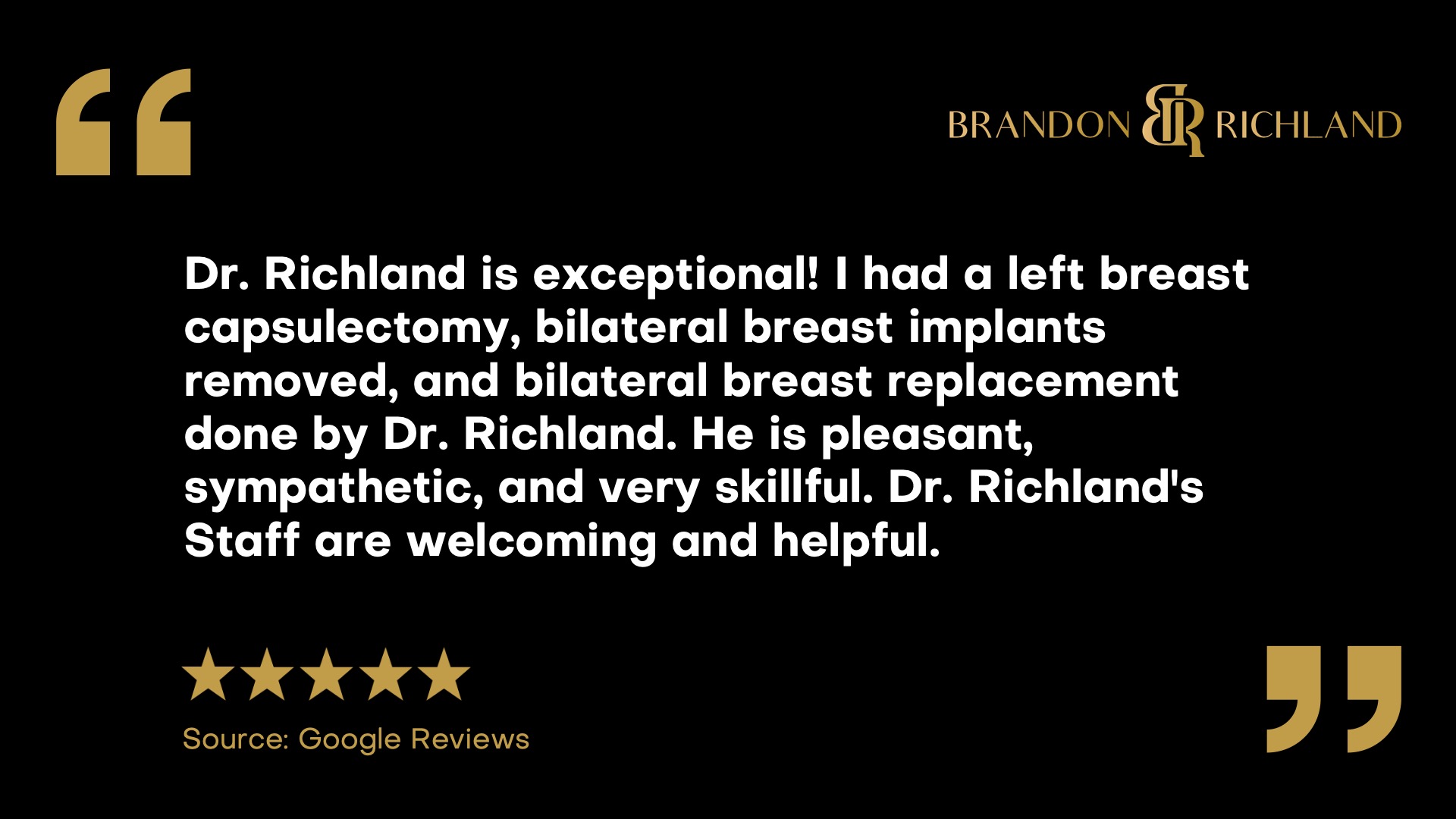Published by Dr. Brandon Richland, MD

“Dr. Richland is exceptional! I had a left breast capsulectomy, bilateral breast implants removed, and bilateral breast replacement done by Dr. Richland. He is pleasant, sympathetic, and very skillful. Dr. Richland’s Staff are welcoming and helpful.”
Read the full Google Review here.
Understanding Breast Implants
Choosing to undergo breast implant surgery involves considering various factors such as implant types, procedure specifics, and the potential risks involved.
Types of Breast Implants
Breast implants are primarily categorized into two types: saline and silicone gel. Saline implants consist of a silicone shell filled with sterile saltwater. They are inserted empty and filled once in place, allowing for size adjustments during surgery. On the other hand, silicone gel implants are pre-filled with a silicone gel that closely mimics the feel of human fat, providing a more natural texture. Surgeons tailor the choice of implant to the patient’s body type and desired outcome.
Safety and Risks
While breast implants are generally safe, they do carry risks. Some complications include implant rupture, capsular contracture (scar tissue formation around the implant), and breast implant-associated anaplastic large cell lymphoma (BIA-ALCL), a rare form of non-Hodgkin’s lymphoma. The FDA monitors the safety of breast implants and provides guidelines on the risks. It is important for individuals considering breast implants to discuss all potential risks and safety information with their plastic surgeon.
Procedure Overview
Breast implant surgery can be performed either as part of breast reconstruction following mastectomy or for cosmetic enhancement. The plastic surgeon places the implant either behind the breast tissue or underneath the chest muscle. Reconstruction can occur immediately following breast removal or as a delayed procedure. After surgery, patients are advised on recovery protocols and long-term care of their implants to reduce complications.
Breast Reconstruction Specifics
Breast reconstruction after mastectomy offers a means to rebuild the shape and look of the breast. This section explores the specific techniques used in breast reconstruction, including the use of implants and autologous tissue, and provides guidance on the recovery process and post-surgery care essential for optimal outcomes.
Implant-Based Reconstruction
Implant-based reconstruction predominantly involves inserting a breast implant beneath the chest muscle. Initially, a tissue expander may be placed to stretch the skin and make room for the final implant. Reconstruction can be immediate, following a mastectomy, or delayed, depending on the patient’s medical condition and preference. Acellular dermal matrix (ADM) products are often used to support the implant and improve cosmetic outcomes.
- Immediate Reconstruction: Occurs during the same surgery as the mastectomy.
- Delayed Reconstruction: Happens at a later date, sometimes following radiation therapy.
Autologous Reconstruction Options
In autologous tissue reconstruction, a surgeon uses the patient’s own tissues, referred to as tissue flaps, to create a breast mound. These flaps can be harvested from various parts of the body, such as the abdomen or back. The focus is on achieving natural cosmetic outcomes and restoring breast sensation. This method might include:
- DIEP flap: Uses abdominal skin and fat without taking muscle.
- Latissimus dorsi flap: Utilizes muscle and skin from the back.
Recovery and Post-Surgery Care
The recovery process varies depending on the type of reconstruction. Patients can expect several weeks of recovery, during which time they might deal with scar tissue and changes in breast sensation. It’s crucial to follow the plastic surgeon‘s recommendations meticulously to aid healing and reduce the risk of complications. Post-surgery care includes:
- Managing pain and swelling: Using medications and wearing special support garments.
- Nipple reconstruction and tattooing: Can be performed to restore the natural appearance of the breast, often after initial recovery.
- Monitoring for complications: Such as infection or breast implant issues.
Considerations and Outcomes
When considering bilateral breast implants, individuals should fully comprehend the potential physical and emotional impacts, be aware of possible post-surgery complications, and have realistic expectations about long-term maintenance and the quality of life outcomes.
Physical and Emotional Impact
Breast implants can significantly alter a person’s body image and self-esteem. Cosmetic outcomes play a crucial role in how individuals perceive their new bodies post-surgery. Achieving symmetry often enhances satisfaction, whereas asymmetry might affect one’s emotional well-being. It’s imperative for prospective patients to discuss with their surgeons what to realistically expect and to consider psychological support if they experience emotional upheaval post-operatively.
Post-Surgery Complications
Surgical complications associated with bilateral breast implants may include infection, bleeding, and capsular contracture, where hard scar tissue forms around the implants. These complications can necessitate additional surgeries and impact recovery time. Here is a concise summary:
Complication:
Infection: Potentially caused by bacteria during surgery. Can lead to swelling and pain.
Impact on Recovery: May prolong healing, require antibiotics or additional surgery.
Bleeding: Can occur internally post-operatively.
Impact on Recovery: Might require immediate attention to prevent further complications.
Capsular Contracture: Scar tissue that squeezes the implant.
Impact on Recovery: Can cause discomfort or need for revision surgery.
Patients who smoke are advised to quit smoking well in advance of the surgery, as tobacco use can impair healing and increase the risk of complications.
Long-Term Expectations and Maintenance
Long-term considerations include the potential for implant rupture and the necessity for future replacements or removals. Routine breast cancer screening is still possible but may require specialized techniques to ensure efficacy. Maintenance of implants may involve regular check-ups and potentially MRI scans to detect silent ruptures, especially with textured breast implants. Monitoring for changes in and around the breast area is essential, and patients should ensure ongoing communication with their healthcare providers to maintain both their physical health and quality of life.
Patients with collagen-vascular diseases should be aware that certain conditions may heighten the risk of capsular contracture. Collaborating with healthcare providers to determine the best approach is vital for maintaining one’s health and navigating the journey with breast implants wisely.
Schedule Your First-Class Cosmetic Consultation with Dr. Brandon Richland, MD
Contact Dr. Richland today by visiting RichlandMD.com, scheduling a cosmetic consultation, or by calling 714-844-0398 or 949-997-2958 directly.











